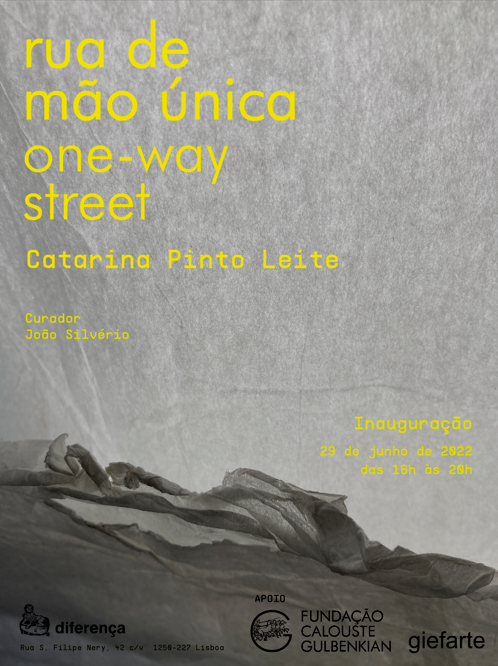
Junho 2022
Suspend, feel, look
The “Rua de mão única” [One-Way Street] installation is a project that Catarina Pinto Leite has been developing for several years. It did not immediately come under the aegis of Walter Benjamin’s One-Way Street, but that volume’s relevance eventually became manifest in a working practice that is closely connected to the studio and to the vocabulary of materials, that is to say, to the way they are handled, transformed, glued, superimposed, replicated and distended. In short, to a mode of life that is deeply involved with artistic practice, moods, disenchantments, hope, passion, watchfulness, discipline, knowledge and experimentation. Catarina Pinto Leite is proficient in the handcrafted approach demanded by her work, namely in a variety of techniques for working on Japanese paper. This relationship between proficiency and experimentation is the source of the underlying concept of the installation in the Diferença gallery’s space, a concept that achieves material form to offer us an experience connected to the idea of a self-referential, subtly intimate itinerary. This turns the gallery into a metaphor of the home, a space of work, intimacy and reflection in which literary and philosophical texts are read, like the book by Walter Benjamin whose title this exhibition borrows. Such is the main context of the artist’s work, which offers us a place of encounter, memory and transitoriness, somewhere between the public and private realms. A work of art that is a site-specific installation, having been conceived solely for this particular location; it may still be a one-way street or a home in another location, but will never have the same meaning or offer the same subjective experience as the work installed in this gallery.
Let us return to Benjamin’s aphorisms, whose reading has consolidated this artistic project: in one of them, “Interior Decoration”, we find a description of the tractatus in its Arabic formulation, and of how the exterior, i.e. what is outside and lends it a first, apparent form, engages with the interior, i.e. what is inside it: “The surface of its deliberations is not enlivened with pictures, but covered with unbroken, proliferating arabesques. In the ornamental density of this presentation, the distinction between thematic and excursive expositions is abolished.” The artist’s work, through which we walk, does not comprise the development of ornamentation in visual terms; however, it is interlaced and, by analogy, simultaneously homogeneous and formless. It is a dense and yet translucent installation, marked by the gallery’s geometry while having sinuous surfaces that accompany the transit of the body that moves through them. Thus, the installation is the work itself, fragmented but incorporating a concept of multiplicity that defines itself between the sections of the constructed itinerary and the various, almost invisible layers of Japanese paper, soft yet strong, sensuous yet also diaphanous, delicate yet austere.
As a visual work, the exhibition comprises the elements in suspension as well as other elements, the latter framed like intimate spaces within the mundane but shared space. These capsules contain smaller pieces: some are images of photographic origin that combine the precise rectilineal limits of the picture with hand-made folds and superimpositions in the density of the inner layers, like the image we sometimes have of our own memory. And memory, in Pinto Leite’s work, is an inhabited place, an archive of the body’s memory that the artist progressively reveals through gestures as an inscription moulded by time.
The installation takes on the atmosphere of a home, but also of the street; it is both from outside and inside, without revealing itself in life’s interstices, while not neglecting recordings, gestures and their replication. Because, even though they seem the same, they are always others, in different moments and times. In the course of her literary studies and researches, the artist defines a different itinerary, which sometimes coincides with exhibitions of her work. In this instance, and in this gallery, the following quote by Mira Schendel is shared with the visitors: “there is need to paint what you see, or what you feel; just that which lives in us.”
João Silvério